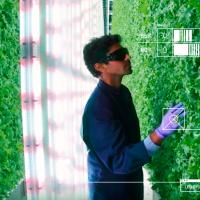By 2050, the world population is expected to rise to approximately 10 billion people — about 2 billion more mouths to feed than today. Meeting that demand will be difficult. Doing so sustainably will be even harder, but perhaps necessary considering that producing more food through current practices would exacerbate both climate change and existing problems with the food supply caused by 20th-century industrial farming.
One example is soil quality. Over the past 150 years, farming has depleted much of the world’s topsoil, while modern industrial practices like monocropping and chemical use have degraded soil quality, directly impacting the quality and amount of food farmers can produce.
“[Industrial agriculture] has absolutely murdered our fields and our agriculture,” James Lloyd Jones, CEO of Jones Food Company, told Freethink. “We’re sleepwalking into a huge agricultural issue with the soil quality around the world.”
Agriculture is one of the leading emitters of greenhouse gases in the world, and to date the industry has cleared an area larger than South America for farmland. Although the world’s fertile land could be a renewable resource, large swaths of it are depleted every year due to farming and climate change, which incentivizes deforestation to create more farmland.
Due to these problems and a growing population, the Food and Agriculture Organization estimated that productive land per person in 2050 will be only a quarter of the level in 1960. As the operator of the largest vertical farm in Europe, the England-based Jones Food Company is an early member of an industry that thinks the future of food is not more agricultural land, but more highly optimized indoor farms.
Vertical farms could be one of the most sustainable ways to meet rising food demand throughout the 21st century.
Transforming agriculture through vertical farming
Since people began farming 12,000 years ago, agricultural productivity has largely been subject to the chaos of nature — uncontrollable factors like weather, insects, and viruses. Space is also an inherent problem in agriculture: Arable land can only produce a finite amount of crops per harvest, and the health of soil degrades over time.
Vertical farming minimizes both problems. Under carefully controlled conditions, plants can grow 365 days a year without sunlight, herbicides, or pesticides. And unlike other indoor farming techniques, vertical farming goes an extra step by optimizing space: Crops are grown on shelves stacked in columns, boosting the productivity of each square meter.
At Jones Food Company’s vertical farm, the process starts with seeding. A machine inserts seeds — currently herbs and lettuce — into a growing medium, which is then inserted into a germination chamber. After germinating, the layers of seedlings are transferred to a growing chamber where they’re connected to a hydroponic system and stacked 17 layers high. The vertical setup provides the chamber with about 26 tennis courts of growing space.
The conditions inside the chamber are carefully controlled to maintain optimal humidity, temperature, and perhaps most importantly, light. There are no windows in the growing chamber: Instead, 7 miles of LED lights provide the plants with energy. To save energy and optimize plant growth, the LEDs emit so-called “light recipes” — specific combinations of spectrum and intensity that are specialized for each crop.
Jones Food Company’s optimized vertical farming system is unaffected by weather, uses no pesticides or herbicides, and is able to achieve 7 to 14 more growth cycles per year than a conventional greenhouse, according to the company. It’s also working toward 100% sustainability.
For example, the company’s hydroponic systems get water from rainfall that’s collected on site, and also from excess moisture in the facility, which is captured and recycled into the system. Solar panels on the roof supply about 10% of the site’s power. And the company uses 100% compostable food packaging.
But while the system may be more sustainable and productive than other agricultural producers, it’s also more expensive.
The economics of vertical farming
The biggest economic disadvantage of vertical farming is the cost of lighting. After all, when you move a farm indoors, you’re giving up the free resource of sunlight. Lighting alone can account for about 30% of a vertical farm’s total operating costs. But that could change soon.
LEDs have become cheaper and more efficient over the past decade, thanks to a combination of research and development into LED technology, rising demand for LEDs in tech products, and laws requiring light bulbs to meet minimum efficiency standards.
As LEDs become more ubiquitous, the costs will almost surely continue to drop. There’s even something called Haitz’s law — an observation about the LED market that states that every decade the cost per lumen drops by a factor of 10 and the amount of light generated per LED package increases by a factor of 20. The law has proven mostly accurate over the years.
Cheaper LEDs have already sparked new interest in vertical farming.
“The first thing that’s got more people involved is the price of LEDs,” Jones told Freethink. “LEDs were hugely expensive, so people didn’t want to build big farms.”
Although lighting remains expensive for vertical farm companies, the industry does have one major economic advantage over conventional agriculture: location.
Vertical farms can grow all sorts of crops nearly anywhere on the planet, unlike agricultural land, which needs to be arable and is typically located far away from consumers.
Being close to customers cuts down the supply chain. Consider how imported produce gets to your grocery store: There’s a good chance much of it was grown hundreds or thousands of miles away before it was packed in a series of transport vehicles, in which the produce was either refrigerated or preserved with chemicals (both of which can affect the taste of the product). Those costs can add up.
Scaling the vertical farm industry
That’s not to say vertically farmed produce is cheaper. Most companies in the industry are selling their produce at premium prices, hoping consumers will pay more for cleaner, more sustainable, and potentially more tasty food.
While the economics of vertical farming remain challenging for Jones Food Company, the startup is already selling its produce to two major retailers at the same price of imported produce. To reach price parity with all conventionally produced produce, the industry will need to drastically lower operating costs. That likely requires scaling up.
“With scale, vertical farms bring certainty with year-round production. You’re able to get closer to the goal of price parity with scale.”
ds and our agriculture,” James Lloyd Jones, CEO of Jones Food Company
Jones Food Company plans to build two more facilities over the next year, both more than twice as big as the existing site in Scunthorpe, England. Jones hopes to eventually automate the process to the point where the company can open a “dark warehouse” — a huge farm run by a single human operator.
“That may sound like science fiction, but it could be very soon — certainly in the next five years,” he told Food and Farming Technology.
Vertical farming won’t disrupt the global food system overnight. But the growth of the industry could speed up as LEDs become cheaper and people become more aware of how industrial agriculture contributes to climate change. The key to a sustainable and efficient food system could be to copy how libraries store books and New York City houses people: build up.


